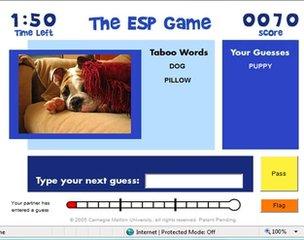Gamification time: What if everything were just a game?
- Published
How Microtask's Digitalkoot game helps weed mistakes out of the Finnish National Library's e-archives
One more step, and a tiny creature will cross the bridge and get to safety.
Just one more step - but letters do not match, the fragile structure blows up and the brown mole falls into a digital abyss.
But as Juha Valtamo, a 21-year-old Finnish student, correctly types the next word that appears on the screen of his laptop, another mole happily reaches the destination.
Digitalkoot may sound like a typical online game - but there is more to it than just building bridges and saving moles.
Every time players complete a level, they help with a real-life task - digitising huge archives of Finland's National Library.
Developed by Finnish start-up business Microtask, Digitalkoot - which means digital volunteers in Finnish - combines two very hot trends in today's business world: gamification and crowdsourcing.
Words that players need to type come from millions of pages of newspapers, magazines and journals, digitised by optical character recognition.
But since machines are prone to make mistakes, a human eye is necessary to weed them out.
While playing, gamers inadvertently cross-check each other, thus ensuring complete accuracy of the word before it gets the final approval.
"It's fun and addictive as a game itself, just like many other mini-games online, but I don't feel like I'm wasting my time because I know I'm doing something helpful," says Mr Valtamo.
"At the university, I've noticed how useful e-archives are, so I can see the immediate advantage of the project.
"And I must admit that it's always nice to see my name and face on the top score board."
Anyone with a computer and an internet connection can play, he says, and don't worry if you don't speak Finnish - there is no need to understand the words.
'Gamifying' crowdsourcing
According to research firm Gartner, 50% of companies that manage innovation and research will use gamification - the use of game-play mechanics for practical applications - by 2015.
One of the pioneers of the trend in its modern, digital-era shape is Luis Von Ahn, the man behind a tagging tool, ESP.
This online game was later bought by Google and became known as Image Labeler.
"It all started in 2002, when image-search used file names and html text - so if you searched for a picture of a dog on Google, you got lots of pictures that somebody named dog.jpg or dog.gif," says Mr Van Ahn.
This was not very precise - and he decided to get people to add tags - brief one-word descriptions - to improve the search.
To motivate users to label millions of photos floating on the web, the young entrepreneur turned it into a game.
"It's a two-player game. When you go on the website, you get randomly paired with another player," explains Mr Von Ahn.
"The goal is to guess the exact same word as your partner, given that you both see the same image.
"Turns out that the best strategy is to type a lot of words related to the common image, until the words of player one are the same as the words of player two.
"Once that happens and the players agree, they get points."
But Microtask's founder and CEO, Ville Miettinen, says that his company's approach is slightly different.

Web users played ESP to label pictures on the internet
While Image Labeler and crowdsourcing firms, such as CrowdFlower, use game mechanics to get users to do real work, "they are not playing games - they are completing fairly trivial web-based tasks", he explains.
"In Digitalkoot, we have people playing actual computer games - and as a side-effect they do useful work."
A similar example would be Fold.it - an online protein-folding game that lets you fold digital proteins.
By playing, you contribute to a remarkable collection of new protein structures - and help scientists get closer to curing diseases like Alzheimer's and Aids.
Banking ideas
But the concept of gamification is more than using the masses to complete simple tasks.
Essentially, it could be defined as applying a competitive game-like setting to any non-game business model to create loyalty, increase the value of the client or generate new ideas.
The word might be new, as well as its applications in today's digital world - but people have been exploiting the notion of tackling a boring task with game mechanics for ages.
We all know it is always easier to get a child to do something through play.
And it turns out that adults are keen on playing, too.
Real-world examples would be a supermarket or airline loyalty programme - the more money you spend, the more points and rewards you get.
Computers, the internet and mobile devices are the companies' dearest friends when it comes to "gamifying" different situations to motivate people, or to change behaviours in a particular way.
Some firms use them internally - getting employees to generate and develop ideas through game-like applications, and rewarding them with virtual badges or prizes.
One example of success could be the UK's Department for Work and Pensions' Idea Street.
This social-collaboration platform is essentially an internal market game, inciting workers to invest in ideas - and develop them to the point they are ready to be implemented.
"It is different from age-old suggestion box," says Gartner analyst Brian Burke.
"Here, people actively participate in idea development, self-select the ones that will get invested in the most and get the most collaboration on."
And it works - according to Gartner, within the first 18 months, some 4,500 workers have used Idea Street - and have generated 1,400 ideas, 63 of which have got implemented.
'Gamifying' the world
There are also businesses that eye the concept in a much broader sense.

Luis Von Ahn is one of the pioneers of applying game mechanics to crowdsourcing
They go external - and aim either to interact with their existent client base, or get new customers.
One of the most famous examples is probably Foursquare, a location-based website that uses game mechanics to drive the site's users to real-life merchants, Foursquare business partners.
"You check-in somewhere, get points, become a mayor - and participating companies offer you rewards for checking in," says Gartner's Brian Burke.
"For example, you can get free coffee when you check-in at a local coffee shop."
Another famous site that successfully connects gamers with businesses is Stardoll - a teen-oriented web page where users create an avatar of themselves and then go shopping for virtual clothes with virtual money.
The catch is that although things they buy online are virtual, the brands are very much real.
Having dressed up the avatar into a cool-looking Miss Sixty mini-skirt, the player may be far more willing to go on a real shopping spree to the brand's nearby store the next day.
Besides innovation, employee performance and marketing, Gartner outlines a number of other areas where gamification is likely to boom in the years to come: training, health and social change.
At the end of the day, we all like to have fun - and in our digital and increasingly mobile world, gamification is proving to be just the right tool to guide that fun down the right channels.